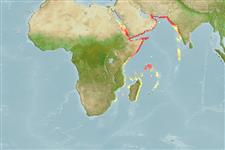Teleostei (teleosts) >
Perciformes/Scorpaenoidei (Scorpionfishes) >
Triglidae (Searobins) > Triglinae
Etymology: Lepidotrigla: Greek, lepis, lepidos = scale + Greek, trigla, es = red mullet (Ref. 45335).
More on author: Regan.
Environment: milieu / climate zone / depth range / distribution range
Ecology
Marine; demersal; depth range 56 - 329 m (Ref. 12965). Tropical
Western Indian Ocean: Gulf of Aden and Gulf of Oman to south India.
Size / Weight / Age
Maturity: Lm ? range ? - ? cm
Max length : 13.5 cm TL male/unsexed; (Ref. 26165)
Minimum depth reported taken from Ref. 30573.
Life cycle and mating behavior
Maturities | Reproduction | Spawnings | Egg(s) | Fecundities | Larvae
Richards, W.J., 1992. Comments on the genus Lepidotrigla (Pisces: Triglidae) with descriptions of two new species from the Indian and Pacific oceans. Bull. Mar. Sci. 51(1):45-65. (Ref. 9204)
IUCN Red List Status (Ref. 130435)
Threat to humans
Harmless
Human uses
Tools
Special reports
Download XML
Internet sources
Estimates based on models
Preferred temperature (Ref.
123201): 15.3 - 23.4, mean 19.6 °C (based on 30 cells).
Phylogenetic diversity index (Ref.
82804): PD
50 = 0.5000 [Uniqueness, from 0.5 = low to 2.0 = high].
Bayesian length-weight: a=0.00676 (0.00325 - 0.01404), b=3.06 (2.88 - 3.24), in cm total length, based on LWR estimates for this (Sub)family-body shape (Ref.
93245).
Trophic level (Ref.
69278): 3.4 ±0.3 se; based on size and trophs of closest relatives
Resilience (Ref.
120179): High, minimum population doubling time less than 15 months (Preliminary K or Fecundity.).
Fishing Vulnerability (Ref.
59153): Low vulnerability (10 of 100).
